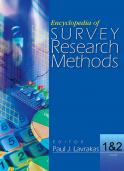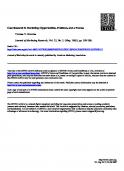Photonovella and Photovoice In: The SAGE Encyclopedia of Qualitative Research Methods
This document was submitted by our user and they confirm that they have the consent to share it. Assuming that you are writer or own the copyright of this document, report to us by using this DMCA report button.
By: Michael J. Emme Edited by: Lisa M. Given Book Title: The SAGE Encyclopedia of Qualitative Research Methods Chapter Title: "Photonovella and Photovoice" Pub. Date: 2012 Access Date: December 27, 2018 Publishing Company: SAGE Publications, Inc. City: Thousand Oaks Print ISBN: 9781412941631 Online ISBN: 9781412963909 DOI: http://dx.doi.org/10.4135/9781412963909 Print pages: 623-624 © 2008 SAGE Publications, Inc. All Rights Reserved. This PDF has been generated from SAGE Research Methods. Please note that the pagination of the online version will vary from the pagination of the print book.
SAGE
SAGE Research Methods
2008 SAGE Publications, Ltd
Photonovella and photovoice are related approaches to participant-driven, photo-based research. Advocates of each form of research are clear about the rich ambiguities and constructedness of the interpretations that their methods evoke. Photonovella is historically most closely connected with popular literature, the arts, and those health and educational researchers interested in working with research participants linked with institutions such as schools or clinics in the development of representational or informational narratives built around sequential images. Photovoice is more closely linked to photodocumentary, engaged journalism, and in some cases, a feminist revisioning of participatory and action research approaches used in visual sociology or visual anthropology. Photovoice has often been used by research participants in community self-study or in needs and asset assessment and can lead to the creation and discussion of photo essays or exhibits that serve as a vehicle for engaging institutions about policy around community concerns. Both approaches highlight the importance of the camera as a tool for supporting the independent inquiry of research participants less constrained by intended or unintended researcher controls, access, and literacy.
Photonovella Photonovella as a research method is linked to photo-based forms of popular literature called fotonovela in Mexico, photoroman in France and Quebec, and fotoromanzi in Italy. Aimed at an adult audience, these magazines featured original tableau photographs or still images from films combined with text balloon dialogue. Like romance novels, radio soap operas, or film melodramas, photonovella typically featured archetypal male and female characters caught in intense relationship crises. As with many popular media, some more recent photonovella have moved to more graphic stories and images. Though photonovella have been commonly available since the 1950s, they were largely ignored or criticized as a low art form in academic circles until fairly recently. In the 1990s, activist Hispanic artists found in the form that was largely unknown to English-speaking cultures a vehicle for exploration and representation. Institutionally, there is evidence back to the 1970s of organizations such as the Peace Corps. in the United States and more recently, health and education agencies such as UNICEF using the photonovella as a means of getting information to communities globally. The method typically involves participants and researchers in identifying both a story important to the group and an audience for whom the creation and distribution of that story is deemed important. This opening inquiry can take many forms, but ideally should involve visual and performative elements, in anticipation of the tableau process to follow. When the group focuses on creating a story, a collective–creative process of performance tableau and photography results in iconic images that are then assembled in a comic book–style sequence. Just as the details of pose and point of view are part of the visual negotiation, the sequencing of the images and the addition of dialogue each represents significant data analysis and manipulation. As visual-literary forms, fotonovela, photoroman, or fotoromanzi (now commonly, and perhaps problematically, anglicized as photonovella in the academic literature) have a number of unique advantages that have proven very useful for researchers interested in gathering, analyzing, and dispersing complex Page 2 of 5
The SAGE Encyclopedia of Qualitative Research Methods
SAGE
SAGE Research Methods
2008 SAGE Publications, Ltd
narrative data in collaboration with diverse communities of participants. Participant-driven, image-based research has demonstrated the power of the camera as a tool for gathering and representing the complexity of research participants' visual culture. Arts-based research involving both individual and collective visual and performance-oriented creation are demonstrating the power of expressive media in supporting research participants in getting at and sharing important stories in a research context. The burgeoning access to more localized publication and distribution of findings is revolutionizing research both in terms of the input that research participants can have in that important final stage of the process, and also in terms of complex reconceptualizations of what counts as the significance and impact of an academic's work. Particularly when all of the digital technologies for gathering, creatively manipulating, and publishing and distributing of data are involved, the photonovella and photovoice forms represent a significant converging of contemporary methodological research opportunities.
Excerpt from Mahamad's First Day in a Canadian School.This frame is selected from a 3-frame story created by immigrant and refugee children in which they combined performance, tableaux photography, digital manipulations and narrative text in cartoon balloons, to represent their memories of their first day in a North American school.
Page 3 of 5
The SAGE Encyclopedia of Qualitative Research Methods
SAGE
SAGE Research Methods
2008 SAGE Publications, Ltd
Photovoice The term photovoice was coined in the mid 1990s and institutionalized more or less simultaneously by several individuals who have each developed support organizations in the past 10 years. It has links to a tradition of engaged journalism and social action that can be traced back to the beginnings of photography. Documentary and poster work on child labor from the 1880s are early examples of this sort of documentary with social purpose. Technological advances that simplified both photography and the mass publication of images have lead to expanded use of photographs in both journalism and social science research since the 1920s and 1930s. By the 1960s, these approaches had evolved and converged to the point that visual anthropology and visual sociology were each recognized (if somewhat marginalized) members of the academic community. PhotoVoice (PV) as an organization based in England is specifically a blending of ethnographic method and journalism aimed at supporting the active pursuit of social justice though the support of individuals and institutional projects incorporating participant-generated photographs. These projects can result in richly visual documentation and journalism. The approach can result in exhibitions with socially engaged themes. It also provides visual resources to the participants for use in their own protest or policy-making. Additionally, this approach generates funds that support the individual photographers as well as the PV organization by combining a structure that is part photographer's cooperative image-marketing agency and part social justice NGO (nongovernmental organization). PV as an organization based in the United States is strongly identified with public health research and community-level inquiry. In this context, photovoice is presented explicitly as a research method with strong ties to action research informed by feminist concerns about representation and process. Although the U.S. organization also emphasizes the active involvement of the participants because its secondary attention is to institutions and an academic audience, there is much more focus on human subjects research methodology. The method articulates approaches to research question development, refinement, and data analysis that is based in participant developed visual data and research process. Both organizations are actively involved in exhibition as a significant form of dissemination, but the U.S. approach to photovoice directs its resources toward scholarly publication and the not-for-profit academic press while the British organization is linked to news agencies, mass media, and more of an ethical commerce or fair trade model of exchange.
Michael J. Emme http://dx.doi.org/10.4135/9781412963909.n319
See also • Arts-Based Research • Arts-Informed Research • Visual Narrative Inquiry • Visual Research Page 4 of 5
The SAGE Encyclopedia of Qualitative Research Methods
SAGE
SAGE Research Methods
2008 SAGE Publications, Ltd
Further Readings Emme, M. , & Kirova, A. Fotonovela and collaborative storytelling: Researching the spaces between image, text and body. (2006).,39(2)45–50.
Wang, C. , & Burris, M. Empowerment through photovoice: Portraits of participation. (1994).,21(2).171–186.
Websites PhotoVoice, Social Change Through Photography: http://www.photovoice.org
Page 5 of 5
The SAGE Encyclopedia of Qualitative Research Methods

Related documents
5 Pages • 1,334 Words • PDF • 190.1 KB
7 Pages • 2,462 Words • PDF • 144.2 KB
1,694 Pages • 541,991 Words • PDF • 9.4 MB
35 Pages • 16,906 Words • PDF • 253.6 KB
1,041 Pages • 681,858 Words • PDF • 14.5 MB
330 Pages • 105,316 Words • PDF • 6.3 MB
38 Pages • 14,754 Words • PDF • 258.9 KB
737 Pages • 395,985 Words • PDF • 6.5 MB
9 Pages • 5,285 Words • PDF • 209.9 KB
859 Pages • 388,330 Words • PDF • 6 MB
224 Pages • 108,610 Words • PDF • 46 MB
14 Pages • 8,688 Words • PDF • 519 KB











